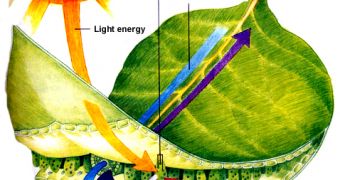The leaf of a tree produces hydrogen from water using natural light. It splits water molecules into hydrogen (to make carbohydrates) and oxygen (released into the air for us to breathe). Photocatalytic cells using the same principle have been previously developed, but they are expensive and their efficiency is still far from being satisfactory.
Now, engineers at Washington University in St. Louis have created a brand new photocatalytic cell that splits water to produce hydrogen and oxygen in water, just like leafs do, using sunlight and the power of a nanostructured catalyst.
They have developed a new method of synthesizing nanostructured films with superior optoelectronic properties. It sandwiches three semiconductor films into a compact structure on the nanoscale range, and is smaller, more efficient and more stable than present photocatalytic methods, which require multiple steps and with a completion time of several hour up to a few days.
The discovery, made by Pratim Biswas, Ph.D., the Stifel and Quinette Jens Professor and Chair of the Department of Energy, Environmental and Chemical Engineering, and his graduate student Elijah Thimsen, involves the well-controlled, gas phase process, and has been demonstrated for synthesizing a variety of oxide semiconductors such as iron and titanium dioxide films in a single step process. It relies on a simple, inexpensive flame aerosol reactor (FLAR) and consists of four mass flow controllers to regulate process gases, a standard bubbler to deliver a precursor, a metal tube that acts as a burner and a water-cooled substrate holder.
"We put these films in water and they promote some reactions that split water into hydrogen and oxygen," said Biswas. "We can use any oxide materials such as titanium dioxide, tungsten oxide and iron oxide in nanostructures sandwiched together that make very compact structures. The process is direct and takes only a few minutes to fabricate. More important, these processes can be scaled up to produce larger structures in a very cost effective manner in atmospheric pressure processes."
It's a discovery that will provide a new, efficient and cheap method for hydrogen production and can be used for a variety of distributed energy applications.

 14 DAY TRIAL //
14 DAY TRIAL //